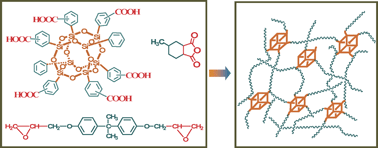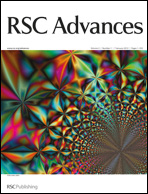Polycarboxyl octaphenylsilsesquioxanes (polycarboxyl-OPS) containing different numbers of reactive carboxyl groups per OPS molecule were synthesized, which were then utilized as nanofillers and macromolecular cross-linkers to cure diglycidyl ether of bisphenol-A (DGEBA) to yield a series of novel inorganic/organic polymer nanocomposites. The network structures and cross-linking densities were modulated by varying the contents of polycarboxyl-OPS in the system. The interface between OPS and DGEBA matrix was remarkably enhanced by the strong covalent bonds as evidenced by the complete disappearance of the carboxyl absorption at 1699 cm−1, the epoxy group at 915 cm−1 and the newly emerged strong peak of ester bond at 1725 cm−1 in the FTIR spectra. All the OPS/DGEBA cured samples are transparent, and the wide angle X-ray diffractions (WAXD) exhibited similar amorphous patterns to the pure DGEBA resin, whereas the peak at ∼8° corresponding to OPS aggregations were absent, indicating a homogeneous dispersion of OPS within the DGEBA matrix. The correlations between network structures, viscoelastic behaviors, cross-linking densities, inter-segmental distances, glass transition temperatures, flexural properties and thermal stability of OPS/DGEBA products were systematically investigated by means of dynamic mechanical analysis (DMA), DSC, TGA, scanning electron microscopy (SEM) and WAXD methods.

You have access to this article
 Please wait while we load your content...
Something went wrong. Try again?
Please wait while we load your content...
Something went wrong. Try again?


 Please wait while we load your content...
Please wait while we load your content...